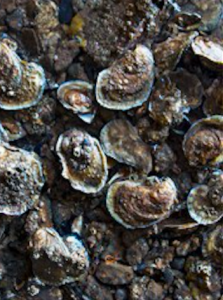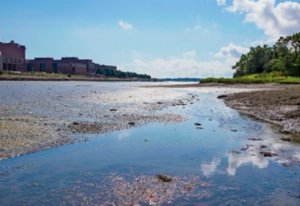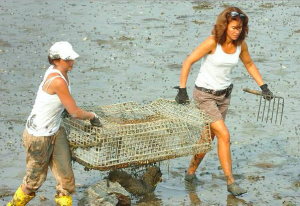“Watch your step.”
On a brisk November morning, I found myself at Savin Hill Cove, where the Neponset River meets the Atlantic Ocean just south of Boston. This is one of the sites of the Green Harbors Project, an environmental restoration program founded and directed Dr. Anamarija Frankic. An ecologist and Biomimicry Fellow at UMass Boston, she and her students are using biomimicry – the application of nature-inspired solutions – to revolutionize the health and function of Boston’s harbor.
In her bright yellow windbreaker and tall blue rain boots, Dr. Frankic expertly leads me through coastal underbrush down to the water, where she points out debris and pollution that plague the cove. Over the course of several decades – even centuries — urban wastewater and nutrient-rich pollution have destroyed Boston’s coastal habitats, creating dead zones devoid of vegetation and aquatic wildlife.
After Vice President George H. W. Bush declared it “the dirtiest” harbor in America in 1988, Boston finally launched a massive multi-billion dollar cleanup project that spanned over a decade. The project culminated in a Deer Island Sewage Treatment Plant renovation that installed a 9.5 mile pipeline which diverted raw sewage beyond the harbor and out into the ocean. While the water quality has improved, Frankic knows more must be done to restore a resilient and sustainable coastal ecosystem in this urban harbor. To do so, she’s enlisted the help of a natural ally: oysters.

Oysters from a reef in Savin Hill Cove. Photo: Ron Cowie
Oysters were once an abundant feature of Boston’s colonial-era harbor. Records from the 1630s describe oyster banks large enough to keep boats from navigating Boston’s rivers, and oyster shells were even a popular material for paving colonial Boston’s streets. By the beginning of the 20th century, however, overfishing, pollution, and habitat degradation from landfill and dams drove the native oyster population to extinction.
Why bring oysters back? Oysters are natural filtration machines: as filter feeders, oysters naturally remove overabundant micronutrients like nitrogen and phosphorous from the water. In fact, one adult oyster can purify 50 gallons of water per day. Simply by existing, oysters improve water quality and make aquatic environments more conducive for other forms of life.
Oysters’ abilities are not limited to water filtration: oyster reefs also stabilize coastal sediment from erosion, provide shelter for creatures like snails and crabs that like to hide in the crevices between oysters, and are a food source for larger organisms, like birds and humans. An increase in their population could even help the Massachusetts fishing economy.
In an adjacent cove, Dr. Frankic and I carefully make our way down a rocky slope to the water at low tide to check the health of an oyster bed she established in 2013. What was once a desolate cove now holds a giant cluster of 150,000 oysters. As we explore the bed, Frankic’s admiration of oysters bubbles up to the surface. “Oysters are smart. They like to live together, to be close to one another for support and for protection.”

Oyster beds stretch out into the water at Savin Hill Cove. The UMass Boston campus sits on the horizon.
Photo: Ron Cowie
Frankic then draws my attention to abundant slimy, leafy plants that line the rocky shore, suitably named rockweed. Its existence here is a good sign – an indication that the oysters are helping to reestablish a livable habitat.
Despite signs of the project’s progress, there is still more work to be done. Her UMass Boston students are busy restoring eelgrass and salt marsh grasses – plants that work in tandem with oyster reefs to attract aquatic life – and exploring other natural technologies to facilitate the process of coastal ecosystem recovery.
And sometimes, there are setbacks. As we walked further into the oyster bed, Frankic stopped short. “Someone was here,” she said grimly. “This area has been raked.” Sure enough, a long strip of bare sand cut through the bed. This is the first time she has ever seen the bed damaged. When asked why someone would do this, Frankic was at a loss – perhaps it was an accident, an act of hostility, or someone harvesting the oysters to eat or to sell.

Dr. Frankic (right) and her students regularly perform research to analyze ecosystem health.
Photo: Green Harbors Project
Dr. Frankic is used to challenges in her career. After growing up on a small Croatian island and attending university in Zagreb, she commenced a nonlinear journey to ecosystem restoration. “I didn’t have a simple track. I just went like organic growth, like a sprout of mold going everywhere.” Her aptitude for holistic and interdisciplinary thinking, however, meant overcoming professional challenges. “I tried to fit the form in science, in academia, in government, in the World Bank and the UN,” she recalls, but time and time again she became frustrated by a culture of fragmentation and compartmentalization, and a lack of collaboration across sectors.
Tired of compromising efficacy to conform to the status quo, Frankic carved out a niche of her own creation. In addition to teaching at UMass Boston and two universities in Croatia, she also works to engage local residents, politicians, fisherman, and elementary school students in ecosystem restoration.
She works as an educator to make it easier for future generations to follow a holistic path like hers. “Education needs to follow the needs of the next generation, and we are not very good in that,” she says. Rather than create reactionary solutions to environmental problems, she wants her students to be leaders that proactively create healthy and thriving environments. By empowering students to perform exploratory field research and question existing systems, she hopes her students will promote positive change in the world.
Already, the positive ripples from the Green Harbors Project are spreading beyond Boston. Dr. Frankic now has oyster restoration projects in Cape Cod, Nantucket, and internationally in her native Croatia. Similar initiatives have been adopted in Brooklyn and the Chesapeake Bay. Inexpensive and low-maintenance, oysters are a natural, simple, and extremely effective tool that can improve aquatic ecosystem health around the world. “Water is life,” she reminds me. “We have to let the water teach us how to build our cities.”